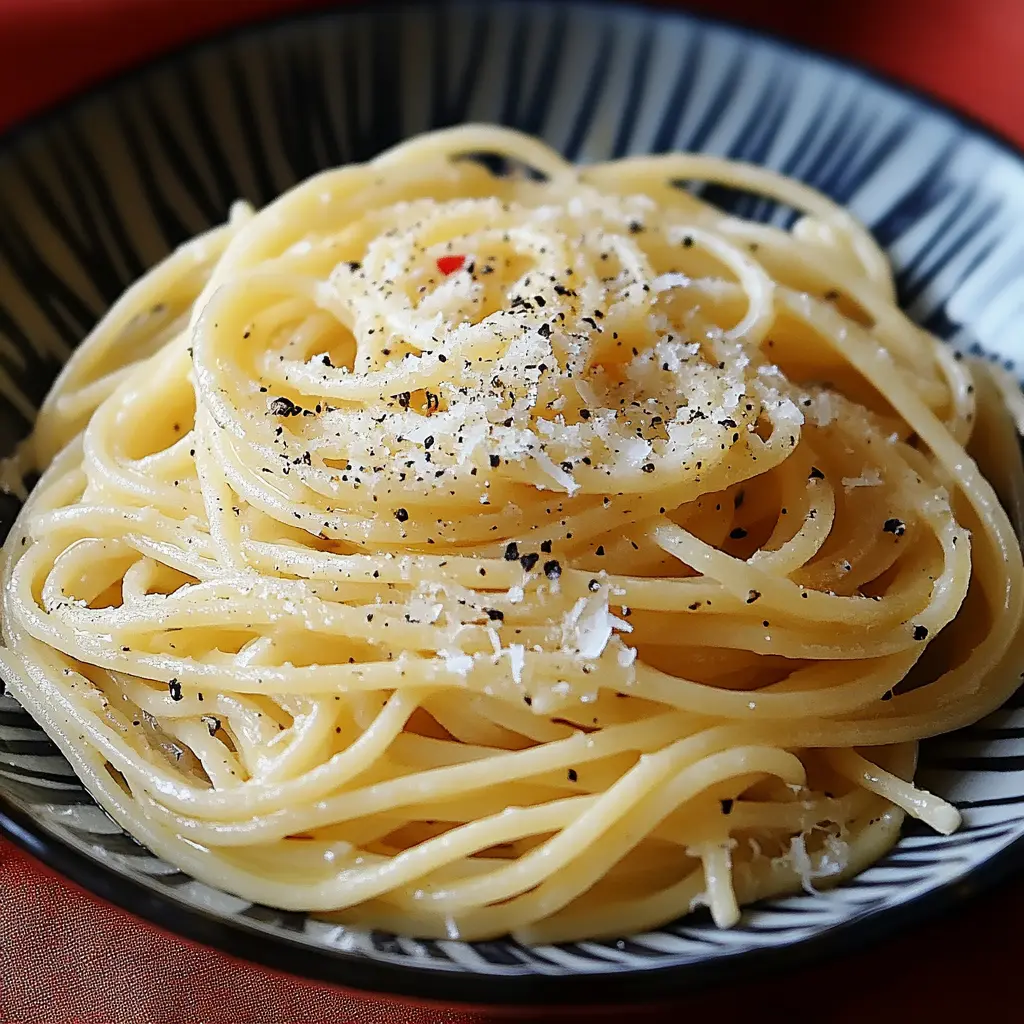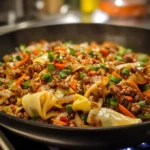Description of this recipe: Spaghetti Cacio e Pepe is a deceptively simple Roman pasta dish that highlights the quality of its few ingredients: spaghetti, Pecorino Romano cheese, and black pepper. The name literally translates to “cheese and pepper,” and that’s exactly what you get – a creamy, intensely flavored pasta that’s both comforting and sophisticated.
Why you will love this recipe: This recipe is quick, easy, and requires minimal ingredients, making it perfect for a weeknight meal. The dish is incredibly satisfying, delivering a depth of flavor that belies its simplicity. Once you master the technique of creating the creamy sauce, you’ll find yourself making this dish again and again. The sharp, salty Pecorino Romano cheese perfectly complements the pungent black pepper, creating a harmonious balance of flavors that will tantalize your taste buds. It’s a dish that celebrates the beauty of simplicity and the importance of using high-quality ingredients. Moreover, it’s naturally vegetarian-friendly, making it a great option for those seeking meatless meals without sacrificing flavor. You’ll also love how adaptable it is; you can adjust the pepper to your spice preference, or even add a touch of heat with red pepper flakes. Ultimately, Spaghetti Cacio e Pepe is a blank canvas for exploring the nuances of Italian cuisine.
Introduction
Spaghetti Cacio e Pepe is more than just a pasta dish; it’s a culinary experience. It’s a testament to the power of simple ingredients and the importance of technique. This dish originates from Rome and has been enjoyed for centuries, embodying the essence of Roman cuisine: hearty, flavorful, and uncomplicated. The key to a successful Cacio e Pepe lies in mastering the emulsion of the pasta water, cheese, and pepper. When done right, the result is a creamy, decadent sauce that coats each strand of spaghetti perfectly.
This recipe aims to guide you through each step of the process, ensuring that you achieve the perfect Cacio e Pepe every time. We’ll explore the importance of using high-quality ingredients, the nuances of toasting the pepper, and the art of creating a smooth, emulsified sauce. Whether you’re a seasoned cook or a beginner, this recipe will empower you to create a restaurant-quality dish in the comfort of your own kitchen. So, gather your ingredients, put on your apron, and let’s embark on this culinary journey together. You’ll be amazed at how something so simple can be so incredibly delicious. And remember, practice makes perfect! The more you make this dish, the more confident you’ll become in your technique, and the more you’ll be able to customize it to your own preferences.
Ingredients:
- 12 oz spaghetti
- 1 cup Pecorino Romano cheese, finely grated
- 1 ½ tsp freshly ground black pepper
- 1 tbsp unsalted butter (optional)
- Salt, for boiling water
Preparation:
Step 1: Cook the Pasta
Begin by filling a large pot with water, ensuring you have enough for the spaghetti to move freely. Generously salt the water; this not only seasons the pasta but also helps it cook properly. Bring the water to a rolling boil over high heat. Once boiling, add the spaghetti. Cook the spaghetti according to the package instructions, but reduce the cooking time by about one minute. You want the pasta to be al dente, meaning “to the tooth,” slightly firm and offering a bit of resistance when bitten. This is crucial because the pasta will continue to cook slightly in the sauce. Before draining, reserve about 1 cup of the pasta water. This starchy water is the key to creating the creamy sauce, so don’t skip this step! Drain the pasta immediately and set it aside.
Step 2: Toast the Pepper
While the pasta is cooking, prepare the pepper. Place a large skillet, preferably non-stick, over medium heat. Add the freshly ground black pepper to the dry skillet. Toast the pepper for about one minute, or until it becomes fragrant and slightly smoky. Be careful not to burn the pepper, as this will give the dish a bitter taste. Toasting the pepper enhances its flavor, releasing its essential oils and adding a depth of complexity to the final dish. Once toasted, remove the skillet from the heat and set it aside.
Step 3: Create the Base
Return the skillet with the toasted pepper to medium heat. Add ½ cup of the reserved pasta water to the skillet. Bring the mixture to a simmer, allowing the pepper to infuse the water with its flavor. The starchy water will start to thicken slightly, creating a flavorful base for the sauce. Let it simmer for about 30 seconds, stirring occasionally, ensuring that the pepper is evenly distributed in the water. This step is essential for creating the characteristic peppery flavor of Cacio e Pepe.
Step 4: Combine Pasta and Sauce
Reduce the heat to low. This is crucial to prevent the cheese from clumping and creating a grainy sauce. Add the drained spaghetti to the skillet with the pepper-infused water. Toss the pasta to coat it evenly with the water and pepper. Ensure that the pasta is well-distributed in the skillet, allowing it to absorb the flavors. This step sets the stage for the magic of the cheese emulsion.
Step 5: Melt the Cheese
Now comes the most important part: creating the creamy sauce. Gradually sprinkle in the finely grated Pecorino Romano cheese while continuously stirring. Add the cheese in small increments, about a tablespoon at a time, ensuring that each addition is fully incorporated before adding more. This prevents the cheese from clumping and ensures a smooth, creamy texture. As you stir, add more of the reserved pasta water as needed. The amount of pasta water you’ll need will depend on the humidity and the consistency of the cheese. You’re looking for a sauce that is creamy, emulsified, and clings to the noodles. The sauce should not be watery or grainy. If the sauce becomes too thick, add more pasta water. If it’s too thin, add more cheese. The key is to maintain a low heat and stir constantly.
Step 6: Enhance (Optional)
For an extra touch of richness and creaminess, you can add a tablespoon of unsalted butter to the sauce. This step is optional but highly recommended. The butter will emulsify with the cheese and pasta water, creating an even smoother and more decadent sauce. Stir the butter into the sauce until it is fully melted and incorporated.
Step 7: Finish and Serve
Continue tossing the pasta until the sauce clings smoothly to the noodles, creating a luscious and creamy coating. This should take about a minute or two. Once the sauce is perfect, remove the skillet from the heat and serve immediately. Cacio e Pepe is best enjoyed fresh, as the sauce can thicken and become less creamy as it sits. Serve the pasta in warm bowls and garnish with extra Pecorino Romano cheese and freshly ground black pepper. The extra cheese and pepper will enhance the flavor and add a beautiful visual appeal to the dish.
COOKING Rating:
- Ease of Preparation: Easy
- Flavor Complexity: Medium
- Time Commitment: Quick (under 20 minutes)
- Ingredient Accessibility: Moderate (Pecorino Romano may require a trip to a specialty cheese shop)
- Overall Appeal: High
Serving Suggestions:
- Serve Cacio e Pepe as a main course for a quick and satisfying lunch or dinner.
- Pair it with a simple green salad dressed with a light vinaigrette to balance the richness of the pasta.
- Add a side of crusty bread to soak up any remaining sauce.
- Serve with a glass of crisp white wine, such as Vermentino or Pinot Grigio, to complement the flavors of the dish.
- For a more substantial meal, add grilled chicken or shrimp to the pasta.
Tips:
- Use high-quality Pecorino Romano cheese for the best flavor. Avoid using pre-grated cheese, as it often contains cellulose, which can prevent the sauce from emulsifying properly.
- Freshly ground black pepper is essential for this dish. The pre-ground pepper will lack the intensity and aroma of freshly ground pepper.
- Don’t overcook the pasta. It should be al dente, slightly firm to the bite.
- Maintain a low heat when melting the cheese to prevent it from clumping.
- Add the cheese gradually, stirring constantly, to create a smooth and creamy sauce.
- If the sauce becomes too thick, add more pasta water. If it’s too thin, add more cheese.
- Serve the dish immediately, as the sauce can thicken as it sits.
- Experiment with different types of pasta. While spaghetti is the traditional choice, other long pasta shapes like bucatini or fettuccine also work well.
- Add a pinch of red pepper flakes for a touch of heat.
Prep Time:
5 minutes
Cook Time:
15 minutes
Total Time:
20 minutes
Nutritional Information:
(Approximate, per serving)
- Calories: 600-700
- Protein: 25-30g
- Sodium: 800-1000mg
Conclusion
Spaghetti Cacio e Pepe is a timeless Roman classic that deserves a place in every home cook’s repertoire. Its simplicity belies its depth of flavor, making it a dish that’s both satisfying and impressive. By mastering the technique of creating the creamy sauce, you’ll unlock a world of culinary possibilities. This recipe is a starting point, a foundation upon which you can build your own Cacio e Pepe variations. Experiment with different types of cheese, add herbs, or even incorporate vegetables to create a dish that reflects your personal taste. The key is to embrace the simplicity of the ingredients and the magic of the technique. So, go ahead, give it a try. You’ll be amazed at how something so simple can be so incredibly delicious. Buon appetito!
Questions and Answers:
Q1: Can I use Parmesan cheese instead of Pecorino Romano?
A: While you can use Parmesan cheese, it’s not recommended. Pecorino Romano has a sharper, saltier flavor that is essential to the characteristic taste of Cacio e Pepe. Parmesan is milder and will result in a less flavorful dish. If you absolutely must substitute, use the highest quality Parmesan you can find and consider adding a pinch of salt to compensate for the difference in flavor.
Q2: My sauce turned out grainy. What did I do wrong?
A: A grainy sauce is usually caused by overheating the cheese or not adding enough pasta water. Remember to keep the heat on low when melting the cheese and add the cheese gradually, stirring constantly. If the sauce starts to look dry or clumpy, add more pasta water, a tablespoon at a time, until it becomes smooth and creamy again.
Q3: Can I make this dish ahead of time?
A: Cacio e Pepe is best enjoyed fresh. The sauce tends to thicken and become less creamy as it sits. If you need to prepare it in advance, consider cooking the pasta and toasting the pepper ahead of time, but wait to make the sauce until just before serving. When reheating, add a little pasta water to loosen the sauce and restore its creaminess.
Q4: I don’t have freshly ground black pepper. Can I use pre-ground pepper?
A: While you can use pre-ground pepper in a pinch, it’s not ideal. Freshly ground black pepper has a much more intense flavor and aroma, which is crucial to the overall taste of the dish. If you’re using pre-ground pepper, you may need to use more of it to achieve the desired level of pepperiness. However, be careful not to overdo it, as pre-ground pepper can sometimes have a slightly bitter taste.
Q5: Is there a vegetarian version of this dish?
A: Yes! Cacio e Pepe is naturally vegetarian, as it does not contain any meat or fish. The only animal product is the Pecorino Romano cheese, which is made from sheep’s milk. If you are vegan, you could try substituting the Pecorino Romano with a vegan Parmesan-style cheese, but be aware that the flavor and texture will be different. You may also need to experiment with different techniques to achieve a similar creamy texture without using cheese.




